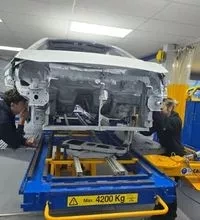Six future technologies you (might) need to be ready for

Zenzic was created by the government and industry to champion the UK Connected and Automated Mobility (CAM) ecosystem. As part of its continuing mission to accelerate self-driving in the UK, it’s Connected and Automated Mobility Scale-Up programme has become a gamechanger for SME’s who win a place on it.
Supported by the government’s Centre for Connected and Autonomous Vehicles each UK-based tech innovator will receive up to £100k and gain access to the world-leading facilities of CAM Testbed UK, including UTAC Millbrook proving ground in Bedford and the Catesby Tunnel aerodynamics centre in Northamptonshire.
Notable graduates from the scheme include Robotiz3d, manufacturer of the world's first pothole-fixing robot, cybersecurity specialist Angoka, solid-state sensor developer Oxford RF, and Dromos, for its dedicated lane automated transit system. And the technologies that come out the other side could well make it into your business at some point.
Zenzic’s Programme Director Mark Cracknell says: “CAM Scale-Up UK is not just about providing funding, it’s very much a wrap-around support programme which provides those successful with everything they need to realise their potential.”
And the winners are:
Each winner has a lot to gain from joining the Scale-Up programme. Here’s who won and the technology they’re developing in Cracknell’s words.
1. Blueskeye AI
“Blueskeye’s clinical grade facial recognition technology uses cameras, microphones and machine learning to understand people's emotional states. The idea is to support the next generation of driver monitoring, driver fatigue detection, so that, as we get closer to level three autonomy, the vehicle will be able to infer whether a driver is able to resume control.”
2. Deontic UK
“Deontic uses generative AI, these large language models which are very much in the news, to help self-driving software meet the new regulatory frameworks. It articulates the self-driving stack’s decision-making, demonstrating in words how the operational design domain (ODD) requirements are being met.”
3. Maaind
“Maaind is another in-vehicle monitoring technology, designed to mitigate mood-based incidents by detecting signs of stress. It takes inputs from smart devices and applies a whole load of datasets to help people progress their journey safely. Longer term, I could see it being integrated into the main vehicle user interfaces.”
4. Moonbility
“Moonbility is focused on accessible and inclusive public transport. Using existing CCTV, it monitors the occupancy of wheelchair bays and provides that information to customers via an app.”
5. Opteran
“Opteran is developing low-cost autonomy solutions using neuromorphic software designed to mimic the structures of the most powerful vision processing engine in the world – the one-foot box on top of your shoulders.”
6. Saif Systems
“Last but not least, Saif Systems does what it says on the tin, providing real-time safety monitoring on a piece of proprietary hardware. Inspired by research into filtering techniques for non-deterministic control systems, the software monitors vehicle commands in relation to the ODD rules. Critically, when safeguards are predicted to be violated, it can take verifiably safe corrective actions.”
This takes us to the heart of some highly complex liability issues. “It’s one of the biggest questions we’re grappling with,” admits Cracknell. “The AV Act has clarified liability and, in doing so, has defined the roles required to deliver CAM services.
“One crucial role is that of the Authorised Self-Driving Entity (ASDE), responsible for the self-driving function, but clearly the insurance sector has a role to play. Is it a back-to-back liability chain of contracts and agreements? The groundwork will be laid over the next 18 months.”
Skills requirements
As to the training and qualifications required to work on cutting-edge CAM technologies, he concluded: “When we think about upskilling dealerships and maintainers to handle increasingly connected and software-based vehicles, there are parallels with the introduction of electric vehicles.
“Third parties must be able to undertake things like diagnostics and sensor calibration, and we’ll see a lot more over-the-air updates. Especially for the deeper levels of self-driving software, these will usually be made by the company that provided it.”
It’s important everyone in the industry stays on top of their skills and what technologies are coming down the line so they’re as prepared as possible. The Scale-Up programme’s winners this year could well see their technologies in the market in the future, so it’ll pay to be prepared.




